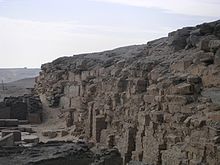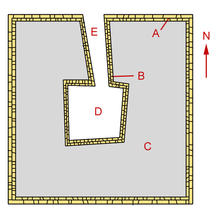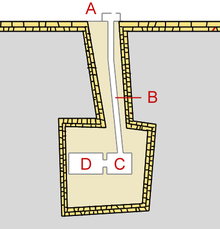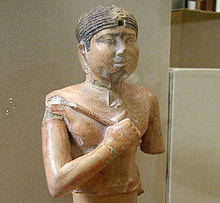Pyramid of Neferefre
| Pyramid of Neferefre | |
|---|---|
 | |
| Neferefre | |
| Coordinates | 29°53′38″N 31°12′6″E / 29.89389°N 31.20167°E |
| Ancient name | |
| Constructed | Fifth Dynasty |
| Type | Smooth-sided pyramid (intended) Square mastaba or Primeval mound (converted) |
| Material | Limestone |
| Height | ~7 m (23 ft; 13 cu)[5] |
| Base | 78 m (256 ft; 149 cu) (intended)[6] 65 m (213 ft; 124 cu) (after mastaba conversion)[7] |
| Volume | 29,575 m3 (38,683 cu yd)[8] |
| Slope | 64°30' (intended)[6] 78° (after mastaba conversion) [9] |
The pyramid of Neferefre, also known as the pyramid of Raneferef, (in
The pyramid was hastily converted into a
South-east of the mortuary temple, a large rectangular mudbrick building was uncovered. This was revealed to be "the Sanctuary of the Knife", an
Location and excavation
Location

The unfinished pyramid is located south-west of
Early surveys

The building was noticed during the early archaeological studies of the necropolis of Abusir, but not subject to thorough investigation. John Shae Perring (1835–1837),[23] Karl Richard Lepsius (1842–1846),[23] who catalogued the ruins as XXVI in his pyramid list,[24] Jacques de Morgan, and Ludwig Borchardt each gave limited attention to the building.[1]
Borchardt carried out a trial excavation at the site, digging a trench into the open ditch that spanned from the north face of the monument to its center. He anticipated that if the tomb was functional, he would encounter the passage leading to the
Charles University excavations and discoveries
A definitive assignment of an owner to the pyramid stump was not possible prior to the 1970s. It was speculatively attributed to Neferefre, or the ephemeral
Mortuary complex
Layout
Main pyramid

A: External wall
B: Internal wall
C: Pyramid step fill
D: Pit for the underground chambers
E: Pit for the entry
The pyramid's condition created the opportunity for a detailed examination of construction methodology employed by pyramid builders in the Fifth and Sixth Dynasties.[33][34] In particular, the Czech team were able to test Lepsius' and Borchardt's accretion layer hypothesis – the method used in the Third Dynasty[34] – for the construction of Fifth Dynasty pyramids.[33][9]
After exploring the Abusir necropolis in 1843,[35] Lepsius developed the hypothesis that the Abusir pyramids were built by layering stone blocks at a ~75° angle against a central limestone spindle on the pyramid's vertical axis.[36] Lepsius justified his hypothesis with the idea that it allowed the pharaoh to expand his tomb gradually over the course of his reign, but if this was the case, then there should be a correlation between regnal duration and pyramid size, yet no such relationship exists.[37] Borchardt, who resurveyed the pyramids between 1902–08,[35] further promulgated the theory after discovering what he believed were accretion layers in Sahure's pyramid.[37] His model of the internal structure of Sahure's pyramid, displayed in the Egyptian Museum in Cairo, and his published plans for the Abusir pyramids garnered the hypothesis widespread support.[36] The Egyptologists Vito Maragioglio and Celeste Rinaldi examined several Fourth and Fifth Dynasty pyramids in the 1960s, but failed to find any evidence supporting accretion layers, and instead found horizontal layers in the structures of the pyramids they visited, including Userkaf's and Sahure's.[37] In the 1980s, the Czech Abusir Mission[34] were able to thoroughly examine the internal structure of Neferefre's unfinished pyramid.[9] The single completed step contained no accretion layers,[9] and in Miroslav Verner's opinion, mostly likely none of the other Abusir pyramids did either.[3]
At the pyramid site, builders had the ground levelled, and measures for the construction of the pyramid base taken.[28] A large east-west oriented rectangular trench was excavated to form the basis of the pyramid's funerary apartments, and a deep north-south oriented ditch dug to form the corridor leading to those apartments.[28] Two layers of massive limestone blocks were then set onto the prepared site, upon which the pyramid superstructure was to be built[21] concurrently with the substructure.[28][7]
The pyramid faces were framed by massive grey limestone blocks up to 5 m (16 ft) by 5.5 m (18 ft) by 1 m (3.3 ft) in size. The inner chambers and passageway were similarly framed, but using much smaller blocks.
The Abusir pyramids were thus constructed in a radically different manner to those of the preceding dynasties.[36] This method of construction, albeit less time and resource consuming, was careless and unstable, and meant that only the outer casing was constructed using high quality limestone.[42] Stripped of their valuable casing, their cores were exposed to further human destruction and natural erosion, leaving the Abusir pyramids as ruinous, formless mounds.[43]
Substructure

A: Entry
B: Access passage
C: Antechamber
D: Burial chamber
The pyramid substructure was accessed from slightly above ground level on the middle of the pyramid's north side. A descending corridor, deflected slightly to the south-east, led to the funerary apartments. The corridor was reinforced with red granite near its terminus, and guarded by a red granite
In spite of the devastation wrought by stone thieves, remnants of the burial have been preserved. Inside the substructure fragments of a red granite sarcophagus, pieces of four alabaster canopic jars, alabaster sacrificial offering containers, and a partial mummy were recovered.[40] The sarcophagus was covered by a convex lid with rectangular end pieces, had body walls 35 cm (1 ft 2 in) thick, and a length of no more than 2.7 m (8.9 ft).[45] The red granite build is noteworthy, as Fifth Dynasty sarcophagi were typically made of greywacke. This suggests that Neferefre's sarcophagus was most likely an emergency solution.[46] The mummy remains have been identified as belonging to a twenty to twenty-three-year-old male, probably Neferefre.[40] Blocks from above the gabled ceiling also regularly contain an inscription reading Hut Neferefre approximately "Burial area of Neferefre".[47] At the end of the corridor, a block with a date rnpt sp tpy, ꜣbd 4 ꜣḫt was uncovered, corresponding to the first or second year of Neferefre's reign, or assuming a biennial census then theoretically a third year, and briefly preceding the interruption of the pyramid construction process.[48]
Mortuary temple

A: Pyramid stump
B: Inner temple
C: Storage magazines
D: Mortuary temple
E: Columned courtyard
F: Hypostyle hall
G: Sanctuary of the Knife
H: Perimeter wall
At the end of the 1970s, with written evidence supporting its existence and a working hypothesis that the tomb was functional, a search was conducted for the mortuary temple of Neferefre's unfinished pyramid by the Czech team. A magnetometric survey of the sand plain on the pyramid's east side revealed a large, articulate, T-shaped mudbrick building buried under the sand. The building was confirmed to be the mortuary temple in the subsequent excavations.[49]
First phase
According to Verner, the time required for burial arrangements was insufficient for anything more than a small improvised cult structure to be completed.[43][5][9] This was built on a 5 m (16 ft) wide strip of limestone platform, retained originally for the pyramid's fine white limestone casing.[43] The temple had a simple layout, with an unusual orientation along the north-south axis,[b] and constructed from fine white limestone.[5][9] Its sole entrance was a low stepped staircase on its south side, that led directly into a vestibule.[43] Here, priests conducted purification rituals prior to entry, as evidenced by a small floor-set basin.[43][5] The remaining temple comprised three chambers.[43] The largest and most significant was the offering hall, which had a red granite false door and an offering altar.[43][31] No trace of the false door and only an impression from the altar remains.[5] Beneath the hall's pavement, the heads of a bull and a bird, miniature clay vessels with gray clay lids, and other offerings were found.[61][5] Flanking either side of the hall were two long narrow rooms, which Verner posits may have hosted the funerary boats.[43] It is unclear who finished the temple after Neferefre's death, but two clay seals bearing the Horus name of Shepseskare, Sekhemkau, were discovered in the vicinity suggesting that it may have been commissioned by him.[62][63]
Second phase
In the second phase of construction, during the reign of Neferefre's younger brother,[10][64] Nyuserre, the temple was significantly extended along its entire length.[62] Constructed predominantly from mudbrick, – a cheaper and less durable alternative to limestone[62][65] – it had a unique design.[66] The architect was clearly influenced by the predicament of building a royal temple in front of a non-standard, non-pyramid royal tomb to break with custom and improvise.[66] He retained the north-south orientation,[65] but moved the entrance to the centre of the eastern façade, underneath a portico adorned with two white limestone lotus stalk columns.[66][67] These supported an architrave, upon which a wood floored roof terrace was built.[66]
Typically, the temple would include an entrance hall, open courtyard, and a five niche statue chapel, but these were forgone.[66] Instead, beyond the entrance a transverse corridor led to five storage magazines,[67] which held equipment for the mortuary cult, and – after a minor fire damaged the northern[65] / western[66] temple – one was repurposed to accommodate the ritual burial of two damaged wooden cult boats, apparently adorned with two thousand carnelian beads.[66][67] The northern sector of the temple contained ten two-story storage magazines, arranged in two rows of five rooms opposite each other, all accessed from a single passage.[66][67] Their arrangement reflected the five phyles of the priesthood that maintained the mortuary cult.[66]

Inside the storage magazines, significant collections of papyri, constituting the third Abusir temple archives, were unearthed.
The most significant architectural discovery was made in the southern temple, where, under nearly 4 m (13 ft) of sand, a long east-west oriented hypostyle hall with twenty-six wooden lotus columns, arranged in four rows of five columns, was uncovered.[71][65][67] Verner states that this was the first discovery of a hypostyle hall from ancient Egypt, which he described as "absolutely unexpected". Its floor was paved with clay, which held the limestone bases of the wooden columns – none of which has been preserved beyond fragments of stucco and polychromatic paint – that supported the approximately 4 m (13 ft) high wooden ceiling.[71] The ceiling has not survived,[71] but remnants indicate that it was blue with painted gold stars.[65] Inside the hall, numerous fragments of statues – diorite, basalt, limestone, red quartzite and wood – of Neferefre, and six complete portraits were recovered.[71] The stone statues were between 35 cm (1 ft 2 in) and 80 cm (2 ft 7 in) tall.[72] One such statue represented Neferefre seated upon his throne with a hedj mace grasped against his chest, a uraeus (originally) on his head, and with the outstretched wings of Horus protecting him from behind.[71] Previously, this motif had been known to exist only from a single diorite statue of Khafre recovered from his valley temple in Giza.[73] Fragments of life-size wooden statues of Neferefre and smaller wooden statues of bound and kneeling enemies of Egypt (Asiatics, Libyans and Nubians) were also found.[74]
Third phase
During Nyuserre's reign, a further reconstruction of the temple was undertaken. It was further enlarged eastward, and an open columned courtyard, an entrance hall and a new columned entrance were added. A pair of limestone papyri-form columns adorned the new entrance, while twenty-two or twenty-four round wooden columns, possibly imitating date-palm trees, adorned the columned courtyard.
Sanctuary of the Knife
South-east of the mortuary temple, a rectangular north-south oriented mudbrick building, built in two phases, was uncovered.[79][75] The building served as a ritual abattoir in service to the mortuary cult.[80][75] Temple archive papyri and vessel inscriptions identify it as "the Sanctuary of the Knife", and preserve an event in which 130 bulls were slaughtered at the abattoir during a ten-day festival.[80][67]
The abattoir had a single, wide entrance in its north side through which cattle, goats, gazelles, and other animals were herded inside.[80] In the north-west of the building was an open slaughterhouse, and in the north-east a butchery where the meat was prepared.[81] There was also a staircase up to the roof terrace, which was perhaps used for drying meats.[82] The remaining abattoir was occupied by storage rooms,[82] which became the only operating area of the building after the third stage of the temple's construction.[67] The abattoir was fully decommissioned and bricked up during the reign of Teti, at the start of the Sixth Dynasty.[78] A Middle Kingdom burial was unearthed in the abattoir, belonging to a hunchbacked – caused by severe tuberculosis of the bone – man called Khuiankh, who had served as one of the last priests of the mortuary cult.[78]
Perimeter wall
The unfinished pyramid and mortuary temple were surrounded by a massive brick perimeter wall, reinforced with limestone monoliths at its corners.[75]
Conjectural wife's tomb
The tomb of Khentkaus III, likely a wife of Neferefre,[83] was discovered near his unfinished pyramid in Abusir.[84] She was buried in a mastaba 16.12 m (52.9 ft; 30.76 cu) long by 10.70 m (35.1 ft; 20.42 cu) wide and with masonry preserved up to a height of 3.30 m (10.8 ft; 6.30 cu).[85] The mastaba superstructure was primarily composed of locally quarried yellow and grey limestone, with a core of mudbrick, limestone debris, and pottery. This was encased in poor quality, unpolished white limestone indicating that construction was abandoned before completion.[86]
Built into the superstructure was an offering chapel containing a vertical shaft leading into the tomb's substructure and burial chamber.
Later history
In the New Kingdom, the mortuary temple was subject to dismantlement from stone quarrying for new projects. The white limestone built first phase of the temple was particularly affected by these attacks.
See also
- Egyptian pyramid construction techniques
- List of Egyptian pyramids
- List of megalithic sites
Notes
- ^ Proposed dates for the reign of Neferefre: c. 2475–2474 BC,[10][11] c. 2460–2453 BC,[12] c. 2448–2445 BC,[13][14] c. 2431–2420 BC,[15] c. 2419–2416 BC,[16] c. 2362–2359 BC.[17]
- akh, the approximate equivalent to a ghost, representing the resurrected form of the king.[54] The pyramid was an instrument which enabled this union to happen.[55] As an akh the king is free to roam the earth and the sky, and is second only to the gods. The purpose of the burial rites and offerings was to allow the akh to form.[54] The king would pass through the false door, have his meal, and then return to his tomb.[56] The food was not physically eaten, rather, it was a token of a meal shared between the living in this world, and the deceased in the next.[57] The corridor leading to the chambers in the pyramid served twin functions: first, to allow passage into the pyramid for the burial and second to allow the resurrected king to leave. From the king's perspective, the corridor ascended into the region of the sky in the north referred to as "the Imperishable Ones" where the king united with the goddess of the sky Nut, who ate the sun at sunset and gave birth to it at sunrise. In effect, she did the same to the king transforming him into a sun god.[58][59] For this reason, the complex took on an east-west orientation, mirroring the sun's path through the sky.[60]
References
- ^ a b c Verner 2001d, p. 301.
- ^ Budge 1920, p. 921.
- ^ a b c Verner 2001d, p. 304.
- ^ Arnold 2003, p. 159.
- ^ a b c d e f g h Verner 2001d, p. 306.
- ^ a b Verner 2001d, p. 464.
- ^ a b c d e Lehner 2008, p. 146.
- ^ Bárta 2005, p. 180.
- ^ a b c d e f g Lehner 2008, p. 147.
- ^ a b c Verner 2001c, p. 589.
- ^ Altenmüller 2001, p. 599.
- ^ Clayton 1994, p. 60.
- ^ Málek 2003, p. 100.
- ^ Shaw 2003, p. 482.
- ^ Allen et al. 1999, p. xx.
- ^ Lehner 2008, p. 8.
- ^ Dodson & Hilton 2004, p. 288.
- ^ a b c Verner 1994, p. 135.
- ^ Edwards 1999, p. 98.
- ^ Arnold 2003, p. 2.
- ^ a b c d Verner 2001d, p. 302.
- ^ Verner 2001d, pp. 294 & 302–303.
- ^ a b Peck 2001, p. 289.
- ^ Lepsius 1913, p. 137.
- ^ Verner 1994, pp. 136–138.
- ^ Verner 2001d, pp. 301–302.
- ^ Verner 1994, p. 133.
- ^ a b c d e f g Verner 1994, p. 138.
- ^ Krejčí 2000, p. 468.
- ^ Bárta 2005, p. 178.
- ^ a b Lehner 2008, pp. 147–148.
- ^ Verner 2001d, pp. 309–310.
- ^ a b Verner 2001d, pp. 303–304.
- ^ a b c d Lehner 1999, p. 784.
- ^ a b Edwards 1999, p. 97.
- ^ a b c d Verner 1994, p. 139.
- ^ a b c Sampsell 2000, Vol 11, No. 3 The Ostracon.
- ^ a b Verner 2001d, pp. 97 & 304.
- ^ Verner 2001d, p. 96.
- ^ a b c Verner 2001d, pp. 305–306.
- ^ Verner 2001d, pp. 97 & 305–306.
- ^ Verner 1994, pp. 139–140.
- ^ a b c d e f g h Verner 1994, p. 140.
- ^ Verner 2001d, p. 305.
- ^ Verner 2000, pp. 565–566 & 570.
- ^ Verner 2000, p. 571.
- ^ Verner 2001d, p. 97.
- ^ Verner 2001a, p. 400.
- ^ Verner 1994, pp. 135–136.
- ^ Lehner 2008, p. 18.
- ^ Lehner 2008, pp. 23 & 28.
- ^ Verner 2001d, p. 52.
- ^ Lehner 2008, p. 23.
- ^ a b Lehner 2008, p. 24.
- ^ Lehner 2008, p. 20.
- ^ Verner 2001d, pp. 52–53.
- ^ Lehner 2008, p. 28.
- ^ Lehner 2008, pp. 28–29.
- ^ Verner 2001d, p. 36.
- ^ Verner 2001d, pp. 45–46.
- ^ Verner 1994, pp. 140–141.
- ^ a b c Verner 1994, p. 141.
- ^ Verner 2001d, pp. 306–307.
- ^ Bárta 2017, p. 7.
- ^ a b c d e f Verner 2001d, p. 307.
- ^ a b c d e f g h i j Verner 1994, p. 142.
- ^ a b c d e f g h Lehner 2008, p. 148.
- ^ Verner 2001b, p. 6.
- ^ Bárta 2017, p. 6.
- ^ Verner 1994, pp. 142–143.
- ^ a b c d e Verner 1994, p. 143.
- ^ Verner 1994, pp. 143 & 145.
- ^ Verner 1994, pp. 143–145.
- ^ Verner 1994, pp. 145–146.
- ^ a b c d e Verner 2001d, p. 309.
- ^ a b Verner 1994, p. 153.
- ^ Verner 2001d, p. 310.
- ^ a b c d e f Verner 1994, p. 154.
- ^ Verner 1994, p. 150.
- ^ a b c Verner 1994, p. 151.
- ^ Verner 1994, pp. 151–152.
- ^ a b Verner 1994, p. 152.
- ^ Verner 2014, p. 58.
- ^ a b Krejčí, Kytnarová & Odler 2014, p. 34.
- ^ Krejčí, Kytnarová & Odler 2014, p. 29.
- ^ Krejčí, Kytnarová & Odler 2014, p. 30.
- ^ Krejčí, Kytnarová & Odler 2014, pp. 30–31.
- ^ Krejčí, Kytnarová & Odler 2014, pp. 32–33.
- ^ Krejčí, Kytnarová & Odler 2014, p. 35.
- ^ Bareš 2000, p. 10.
- ^ Bareš 2000, pp. 14–15.
- ^ Vachala & Ondráš 2000, pp. 73–76.
Sources
- OCLC 41431623.
- ISBN 978-0-19-510234-5.
- Arnold, Dieter (2003). The Encyclopaedia of Ancient Egyptian Architecture. London: I.B. Tauris. ISBN 978-1-86064-465-8.
- Bareš, Ladislav (2000). "The destruction of the monuments at the necropolis of Abusir". In Bárta, Miroslav; Krejčí, Jaromír (eds.). Abusir and Saqqara in the Year 2000. Prague: Academy of Sciences of the Czech Republic – Oriental Institute. pp. 1–16. ISBN 80-85425-39-4.
- Bárta, Miroslav (2005). "Location of the Old Kingdom Pyramids in Egypt". Cambridge Archaeological Journal. 15 (2). Cambridge: 177–191. S2CID 161629772.
- Bárta, Miroslav (2017). "Radjedef to the Eighth Dynasty". UCLA Encyclopedia of Egyptology.
- OCLC 697736910.
- ISBN 978-0-500-05074-3.
- ISBN 0-500-05128-3.
- ISBN 978-0-203-98283-9.
- Krejčí, Jaromír (2000). "The royal necropolis at Abusir during the Old Kingdom". In Bárta, Miroslav; Krejčí, Jaromír (eds.). Abusir and Saqqara in the Year 2000. Prague: Academy of Sciences of the Czech Republic – Oriental Institute. pp. 467–484. ISBN 80-85425-39-4.
- Krejčí, Jaromír; Kytnarová, Katarína Arias; Odler, Martin (2014). "Archaeological excavation of the mastaba of Queen Khentkaus III (tomb AC 30) in Abusir". Prague Egyptological Studies. XV: 28–42. ISSN 1214-3189.
- ISBN 978-0-203-98283-9.
- Lehner, Mark (2008). The Complete Pyramids. New York: Thames & Hudson. ISBN 978-0-500-28547-3.
- OCLC 84318033.
- Málek, Jaromír (2003). "The Old Kingdom (c. 2686–2160 BC)". In Shaw, Ian (ed.). The Oxford History of Ancient Egypt. Oxford: Oxford University Press. pp. 83–107. ISBN 978-0-19-815034-3.
- Peck, William H. (2001). "Lepsius, Karl Richard". In ISBN 978-0-19-510234-5.
- Sampsell, Bonnie (2000). "Pyramid Design and Construction – Part I: The Accretion Theory". The Ostracon. 11 (3). Denver.
- Shaw, Ian, ed. (2003). The Oxford History of Ancient Egypt. Oxford: Oxford University Press. ISBN 978-0-19-815034-3.
- Vachala, Břetislav; Ondráš, František (2000). "An Arabic inscription on the pyramid of Neferefre". In Bárta, Miroslav; Krejčí, Jaromír (eds.). Abusir and Saqqara in the Year 2000. Prague: Academy of Sciences of the Czech Republic – Oriental Institute. pp. 73–76. ISBN 80-85425-39-4.
- ISBN 978-80-200-0022-4. Archived from the original(PDF) on 2011-02-01.
- Verner, Miroslav (2000). "Newly discovered royal sarcophagi from Abusir". In Bárta, Miroslav; Krejčí, Jaromír (eds.). Abusir and Saqqara in the Year 2000. Prague: Academy of Sciences of the Czech Republic – Oriental Institute. pp. 561–580. ISBN 80-85425-39-4.
- Verner, Miroslav (2001a). "Archaeological Remarks on the 4th and 5th Dynasty Chronology" (PDF). Archiv Orientální. 69 (3). Prague: 363–418. ISSN 0044-8699.
- Verner, Miroslav (2001b). "Abusir". In Redford, Donald B. (ed.). The Oxford Encyclopedia of Ancient Egypt, Volume 1. Oxford: Oxford University Press. pp. 5–7. ISBN 978-0-19-510234-5.
- Verner, Miroslav (2001c). "Old Kingdom". In Redford, Donald B. (ed.). The Oxford Encyclopedia of Ancient Egypt, Volume 2. Oxford: Oxford University Press. pp. 585–591. ISBN 978-0-19-510234-5.
- Verner, Miroslav (2001d). The Pyramids: The Mystery, Culture and Science of Egypt's Great Monuments. New York: Grove Press. ISBN 978-0-8021-1703-8.
- Verner, Miroslav (2014). Sons of the Sun. Rise and decline of the Fifth Dynasty. Prague: Charles University. ISBN 978-8073085414.
Further reading
General
- ISBN 9788880952336.
Specific
- Landgráfová, Renata : Abusir XIV. Faience Inlays from the Funerary Temple of King Raneferef. Czech Institute of Egyptology, Prague 2006. ISBN 9788073081300
- Posener-Kriéger, Paule, Miroslav Verner, Hana Vymazalova : Abusir X. The Pyramid Complex of Raneferef. The Papyrus Archive. Czech Institute of Egyptology, Prague 2006. ISBN 9788073081546
- Posener-Kriéger, Paule : Quelques pièces du matériel cultuel du temple funéraire de Rêneferef. In: Mitteilungen des Deutschen Archäologischen Instituts, Abteilung Kairo. (MDIAK) volume 47), von Zabern, Mainz 1991, pp. 293–304 ISSN 0342-1279
- Verner, Miroslav et al. : Abusir IX: The Pyramid Complex of Raneferef : The Archaeology. Czech Institute of Egyptology, Prague 2006, ISBN 9788020013576
- Verner, Miroslav : Les sculptures de Rêneferef découvertes à Abousir [avec 16 planches] (= Bulletin de l´Institut Francais d´archéologie orientale. volume 85). 1985, pp. 267–280 with XLIV-LIX suppl.(PDF) ISSN 0255-0962
- Verner, Miroslav : Supplément aux sculptures de Rêneferef découvertes à Abousir [avec 4 planches] (= Bulletin de l´Institut Francais d´archéologie orientale. volume 86). 1986, pp. 361–366 (PDF) ISSN 0255-0962
- Vlčková, Petra : Abusir XV. Stone Vessels from the Mortuary Complex of Raneferef at Abusir. Czech Institute of Egyptology, Prague 2006. ISBN 9788073081140

